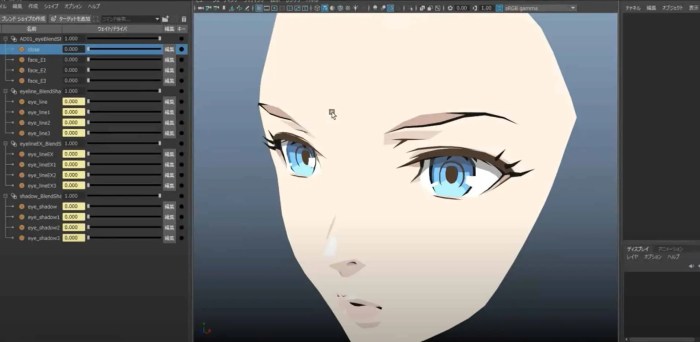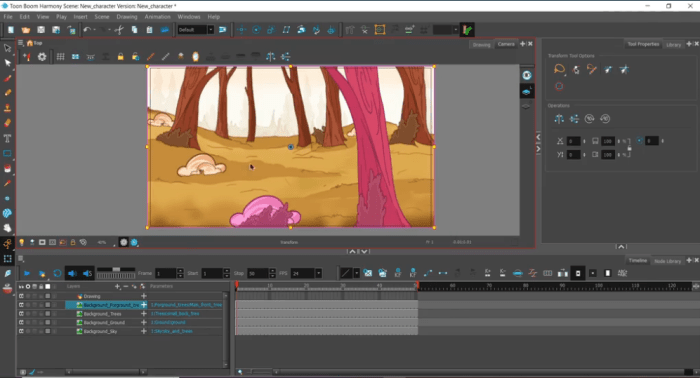User Experience and Interface Design

This section analyzes the user interface (UI) and user experience (UX) of a hypothetical popular free anime coloring program, identifying its strengths and weaknesses and proposing improvements for enhanced usability. The analysis will focus on key aspects of interface design that directly impact the user’s ability to effectively and enjoyably complete the coloring process. Specific examples will be drawn from established UI/UX principles and best practices.
Effective UI/UX design in a digital coloring program is crucial for fostering a positive user experience. A well-designed interface should be intuitive, allowing users of all skill levels to quickly grasp its functionality. It should also be visually appealing, complementing the artistic nature of the application and enhancing the overall creative process. Conversely, a poorly designed interface can lead to frustration, hindering creativity and potentially driving users away.
Strengths of a Hypothetical Anime Coloring Program’s Interface
The hypothetical program’s interface, for example, might excel in its intuitive tool selection. A clearly organized toolbar, featuring easily identifiable icons for brushes, colors, and other tools, could contribute significantly to a positive user experience. Furthermore, a straightforward color palette with easily adjustable saturation and brightness settings could streamline the coloring process, allowing users to focus on their creative expression.
Finally, a responsive interface that adapts seamlessly to various screen sizes and resolutions enhances accessibility and usability across different devices.
Weaknesses of a Hypothetical Anime Coloring Program’s Interface, Free anime coloring program
Conversely, the program might suffer from a lack of clear visual feedback. For instance, the absence of a preview function for color adjustments could lead to unexpected results and necessitate frequent undo actions. Additionally, a cluttered interface with poorly organized menus and tools could overwhelm users, particularly beginners. The absence of customizable keyboard shortcuts could also reduce efficiency, particularly for more experienced users.
Lastly, a lack of readily accessible tutorials or help documentation could create a steep learning curve, discouraging new users.
Proposed Improvements for Enhanced Usability
To enhance usability, the interface could incorporate several improvements. First, the implementation of a layered system would allow users to easily manage different elements of their artwork, offering greater control and flexibility. Second, the addition of a zoom function with smooth transitions would improve precision, particularly for intricate details. Third, the integration of a “recent colors” palette would speed up the color selection process.
Finding the perfect free anime coloring program can be a quest, but don’t limit yourself to just anime! For a change of pace, check out adorable coloring pages from Disney animals , which offer a different style and can help you improve your coloring skills. Then, jump back into your free anime coloring program with fresh inspiration and a broadened artistic perspective.
Fourth, a more robust undo/redo system with multiple levels of undo would reduce the frustration associated with accidental mistakes. Fifth, the addition of customizable brush settings, including size, opacity, and pressure sensitivity, would further enhance artistic control.
Mock-up of an Improved Interface
The improved interface would feature a streamlined toolbar positioned on the left, organized into logical groups (brushes, colors, layers, effects). The main canvas would occupy the central area, providing ample space for the artwork. A color palette with both pre-defined and customizable color options would be situated on the right, alongside a layer panel that displays all active layers and allows for easy manipulation.
The bottom would house a quick-access toolbar for frequently used functions like undo/redo, zoom, and save. Each tool would feature clear visual feedback, such as highlighting the active tool or displaying real-time brush stroke previews. The overall color scheme would be calming and neutral, allowing the user’s artwork to take center stage. This design prioritizes clarity, efficiency, and ease of use, adhering to established UI/UX principles to ensure a positive and productive user experience.
Technical Aspects and Functionality: Free Anime Coloring Program

Free anime coloring programs represent a significant segment of digital art software, offering accessible tools for creating and manipulating digital artwork. Their functionality hinges on a combination of efficient rendering engines, intuitive user interfaces, and carefully implemented features that cater to the specific needs of anime-style art. Understanding the technical underpinnings of these programs is crucial for both users and developers alike.File formats and rendering engines are fundamental to the performance and capabilities of any digital art program.
Free anime coloring applications typically support common image formats such as JPEG, PNG, and sometimes even more specialized formats like PSD (Photoshop Document) for layered artwork. The rendering engine, responsible for displaying the image on screen and handling brush strokes, varies considerably. Many rely on OpenGL or similar graphics libraries for hardware acceleration, enabling smoother performance, particularly with high-resolution images and complex brush effects.
Others may use software rendering, which is less demanding on hardware but can result in slower performance.
Brush Types and Color Palette Implementation
The implementation of different brush types and color palettes is key to the artistic versatility of these programs. Brush types are often simulated through algorithms that determine the shape, opacity, and texture of the strokes. For instance, a “hard” brush might produce sharp, defined lines, while a “soft” brush would create softer, blended edges. These algorithms can be implemented using various techniques, including texture mapping, particle systems, or simply mathematical functions that define the brush’s shape.
Color palettes are typically implemented using color selection tools and color pickers, which allow users to select colors from a variety of sources, including pre-defined palettes, color wheels, and by sampling colors directly from the image. Some programs may also offer advanced color mixing tools, such as HSV or HSL sliders for more precise color manipulation.
Limitations of Free Anime Coloring Programs
Free anime coloring programs, while offering considerable functionality, inevitably have limitations compared to their paid counterparts. These limitations can manifest in several areas. Firstly, feature sets are often more restricted. Paid software often includes advanced features such as advanced layer management, non-destructive editing tools, powerful selection tools, and extensive filter options that are absent or limited in free versions.
Secondly, the level of support and updates may be less frequent or comprehensive in free software. Paid programs usually come with dedicated support teams and regular updates that address bugs and introduce new features. Thirdly, free programs may contain advertisements or limitations on export sizes or file formats. The trade-off is a balance between access and functionality.
Performance and Resource Usage Comparison
A direct comparison of the performance and resource usage of two different free anime coloring programs requires specific examples and benchmarks. However, a generalized comparison can be made. Programs utilizing OpenGL or similar hardware-accelerated rendering will generally exhibit superior performance compared to those relying solely on software rendering, particularly when handling large images or complex brush strokes. Memory usage is also a key consideration.
Programs with more sophisticated features or those that support a larger number of layers simultaneously will typically consume more RAM. For example, a hypothetical comparison between “AnimeColor Free” (using software rendering) and “PaintAnime Pro” (using OpenGL) would likely show “PaintAnime Pro” exhibiting better performance with larger canvases and complex brush strokes, but potentially at the cost of higher RAM consumption.
However, this is a generalized example, and actual performance will vary depending on the specific implementation of each program and the user’s hardware.
Community and Resources

The thriving online community surrounding anime coloring, particularly with free software, offers invaluable resources and support for both novice and experienced artists. These communities facilitate learning, collaboration, and the sharing of creative techniques, ultimately enriching the user experience and expanding the potential of free anime coloring programs. The availability of readily accessible resources, coupled with the interactive nature of these online spaces, plays a crucial role in the program’s overall success and user engagement.The types of resources available to users of free anime coloring programs are extensive and varied, catering to diverse skill levels and artistic preferences.
These resources significantly impact the learning curve and the overall creative process, allowing users to progress at their own pace and explore different styles. Furthermore, the interactive nature of these online communities enhances the learning experience, fostering a sense of community and shared progress.
Online Communities and Forums
Several online platforms host dedicated communities focused on anime coloring and the use of free software. These communities often take the form of forums, social media groups, or dedicated websites. Users can engage in discussions, share their artwork, request feedback, and seek assistance with technical issues. Examples include subreddits dedicated to digital art and anime coloring, Discord servers focused on specific free software applications, and online art communities like DeviantArt, where users can connect with others sharing similar interests.
These platforms offer a crucial space for collaboration, learning, and the exchange of ideas, promoting a vibrant and supportive environment for users.
Types of Resources Available
Users of free anime coloring programs have access to a wealth of resources that greatly enhance their artistic capabilities. Tutorials, ranging from beginner-level introductions to advanced techniques, are readily available on video-sharing platforms like YouTube and through written guides on blogs and websites. These tutorials often cover various aspects of the coloring process, including line art cleaning, base coloring, shading, highlighting, and special effects.
Pre-made templates, featuring line art of various anime characters or scenes, provide a convenient starting point for users who wish to focus on the coloring aspect without the need for initial sketching. Color palettes, curated collections of harmonious color combinations, can inspire creative exploration and ensure consistent color schemes throughout a piece. These palettes are often shared within online communities or created by individual artists and made available for public use.
Benefits and Drawbacks of Online Communities
Utilizing online communities for learning and sharing anime coloring techniques offers numerous benefits. Direct interaction with other artists fosters a supportive learning environment, enabling users to receive constructive criticism, share tips and tricks, and learn from the experiences of others. The collaborative nature of these communities can inspire creativity and help users develop their unique artistic styles. However, drawbacks exist.
The quality of information and advice shared online can vary significantly, and users should be discerning in the sources they consult. Furthermore, the potential for negative interactions or unproductive criticism necessitates careful engagement and a focus on constructive feedback.
Useful Websites and Resources
The following list provides examples of useful websites and resources for users of free anime coloring programs. Note that the availability and accessibility of these resources may vary over time.
- YouTube: Offers a vast library of tutorials on anime coloring techniques using various free software programs.
- DeviantArt: A popular online art community where users can share their artwork, find inspiration, and connect with other artists.
- Pinterest: A visual discovery tool with numerous boards dedicated to anime coloring, providing inspiration and ideas for color palettes and techniques.
- Various subreddits (e.g., r/digitalpainting, r/anime): Offer dedicated communities for discussion and sharing of digital art, including anime coloring.
- Blogs and websites dedicated to digital art tutorials: Numerous personal blogs and websites offer tutorials and resources specific to anime coloring and free software.
